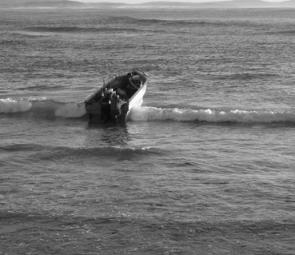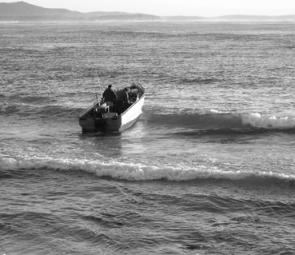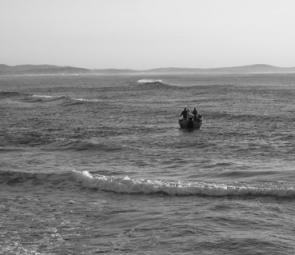Once you have complete faith in your boat and your ability, launching through the surf can lead to more fish, lower fuel bills and fewer crowds.
SECTION: feature
MAPS:
Facts
ILLUSTRATIONS: 0
Launching your boat off the beach has many advantages: It can cut your travel time to good reef, reduce fuel consumption and get you out of the mad scramble that surrounds the more popular ramps.
However, towing the boat onto the sand always has the possibility to bring you unstuck as there are numerous variables that must be considered.
In Port Stephens, Fingal Beach and Boat Harbour are two of the very best beach-launching sites along our coastline but you can bet your bottom dollar that visitors and the inexperienced will get themselves into more strife than Speed Gordon week in, week out.
I have been pushing my boats into the surf from Kiddies Korner, Fingal Bay, for 30 years and the mistakes that I witness these days are no different from those made decades ago.
With the short distance to travel across the sand, I don’t lower the pressure in my tyres except during the Summer holidays when the sand is dry, soft and rutted by heavy traffic and there a real chance of getting bogged. I simply drop into low-range second gear and drive at a steady pace.
Visitors get into real strife when they don’t consider the change in tide and the associated problems. The sand at low tide is flatter and firmer, making driving a breeze until it comes time to back the boat into the water. Water deep enough to float the boat could be as far as 30m to 40m out, particularly if there is a low tide of 0.1m or 0.2m.
Some are tempted to reverse the distance to the deeper water but I prefer to wait for the tide to come in.
Returning on the low can leave you stranded 40m from the shore. Again, there are those who back out and then slowly sink as they winch the boat onto the trailer. It’s embarrassing to be bogged 40m out on an incoming tide.
Sliding a couple of pieces of ply under the tyres of the trailer before the boat is retrieved can help spread the load and make it easier to drive away but it’s a lot of trouble. I just wait until the tide comes in before returning to the beach.
Some choose to use a long tow rope between the trailer and boat and then drag the boat up to firmer sand and back the trailer underneath. I find it easier to just wait another hour or so for the tide to run in if the conditions allow me to stay out.
High-tide launching causes all sorts of problems, particularly if it is accompanied by a little shore break.
Having a mate to help is invaluable. I unhook the boat from the winch cable, then back the trailer into the water and then hit the brakes, allowing the boat to slide off the trailer. It’s then up to my mate to quickly turn the boat into the on coming swell.
I have the luxury of having two boats. Stinkpot is a cracker little 3.3m Savage Gull which I use when fishing by myself. Beach-launching this tinny is a snack.
Stinkin’Hot, the 4.6m job, can be awkward at times. Those who attempt to slide boats over 5m into the surf frequently get into big trouble.
The only problems that I experience occur during the festive seasons when the beach is alive with kids, who have the frightening habit of running straight at your truck, forcing you to stop. The fun really begins if the sand is deep and soft.
To avoid this problem I go fishing well before sunup and return before the daily invasion or head out in the evenings and return in the dark.
Night on the beach in holiday time poses a few unique obstacles – the giant holes that the kids dig in their efforts to reach China. If you are unfortunate enough to be gobbled up by one of these XOS potholes, for that split second you get the feeling that you are indeed on the way to the Orient.
Facts
BEFORE YOU TRY
• The best advice I can pass on to would-be beach-launchers is to spend an hour or so and watch how others approach the task. Each beach has its own tricks to be learnt and the locals know the ropes. Their boats and their methods work and are worth imitating.
• You should not attempt any of this if you are not fully confident that you can get your boat off and on the trailer efficiently in absolutely no time.
• Nor should you try it unless you’re certain your outboard will start first kick. Some people ‘dry-run’ their engines for a few seconds while still on the trailer but this isn’t real good for the water pump. You could always get the engine warmed up on some flusher ‘headphones’ if there’s a tap nearby.
• Have absolutely everything secure in the boat, either stowed away or tied down. Fishing gear, tackle boxes, batteries and fuel tanks have a habit of wandering around if the boat cops a wave. Have a bailing bucket handy and the lanyard tied to the boat.
• Although it’s not law to wear a lifejacket while beach launching, it’s a pretty good plan – especially if you’re young, old or a poor swimmer.
• As usual in all boating, if in doubt, don’t go out! If the waves are too powerful or the beach too shallow or boggy, leave it for another day.

This boat has been rolled off the trailer and turned to face the waves.

‘Thanks, boys!’ Many hands make light work at this stage – especially with boats over 4m – as the craft begins to float on the wavelets. Smaller tinnies can be just pushed off and rowed into water deep enough to start the engine.

‘We’re on our own now!’ The deckie has already clambered aboard and the skipper gives a last push forward, ensuring the boat is at 90° to incoming waves. A transom boarding platform is essential for larger boats and handy for any size.

This is no time to be saying, ‘Start, you %^*#&!’ Power tilt is a huge advantage in quickly lowering the engine but rocks and hard sand here could mean some ugly moments in the wave troughs. The prop is lowered just enough to give it some water to work wi

‘Now let’s go fishing!’ As soon as there’s enough water, the outboard is completely lowered to give the prop maximum efficiency. Then it’s just a matter of timing the exit between the abeam waves and zipping out through the open gutter.




